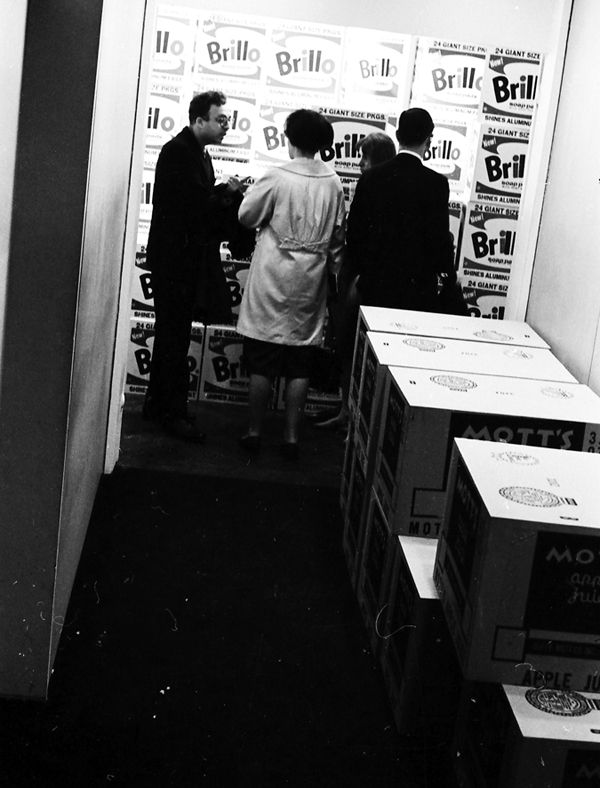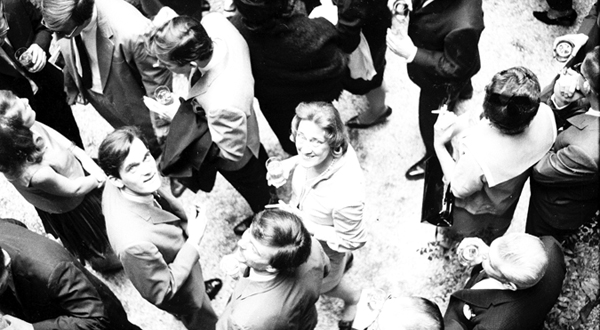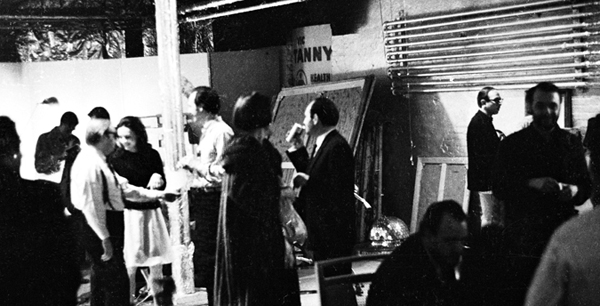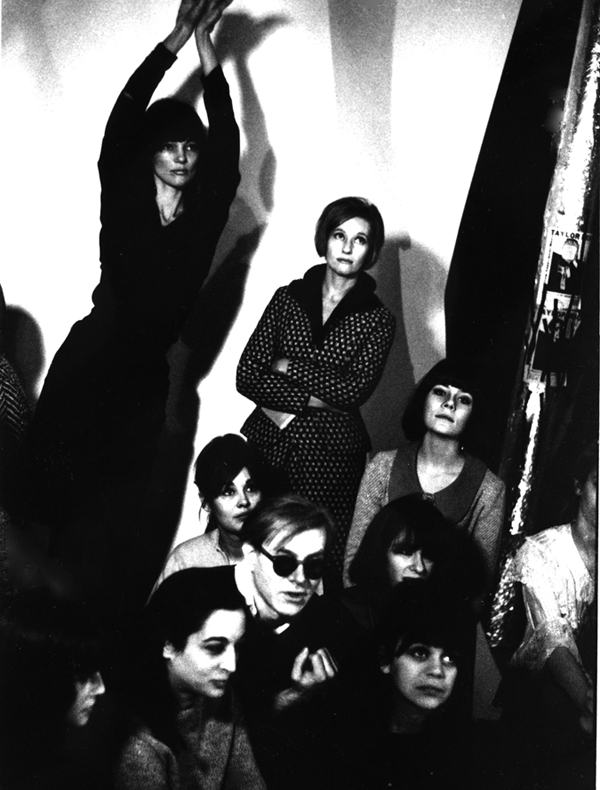ALL TOMORROW’S PARTIES
And what costume shall the poor girl wear, to all tomorrow’s parties?
—Lou Reed
The title refers to Warhol’s favorite Velvet Underground song, written by Lou Reed for Nico in 1966. In the early days of the Factory, while Lou and the Velvets were being regularly tossed out of downtown clubs, Warhol and Gerard enjoyed listening to the Rolling Stones (Mick would later be a bit of a regular) and the Supremes as they diligently worked in the front of the loft space, while Billy and Ondine would be in the back singing along with Maria Callas to ‘Aida’ and ‘Lucia de Lammermoor’ …
* * *
Billy Name: The first gallery as you walked into the Stable Gallery is a diamond formation of Campbell’s box sculptures. You have to walk through them to get through the place. It was spectacular! And there was going to be this big party afterward at the Factory—the first big party. Elinor Ward, who owned the Stable Gallery hired Pinkerton Guards and everything, and you had to be pass through them before you could get to the elevator and go up to the Factory.
* * *
At his busy Brillo Box opening in 1964, the CBS network and the CBC (Canadian Broadcasting) interviewed Warhol in Elinor Ward’s Gallery. Surrounded by mounds of plywood boxes silk-screened with the logos of Campbell’s Tomato Juice, Kellogg’s Corn Flakes, and lots of Brillo boxes. Warhol, in sunglasses, was his usual deadpan monosyllabic self, to the dismay of acerbic CBS reporter Mary Pangalos, who at this point had interviewed heads of state and countless less troublesome celebrities.
* * *
Mary Pangalos Manilla: I had the hardest time getting the guy to say something. And I’d been nominated for two Pulitzers!

Andy and art dealer Ivan Karp with CBS interviewer Mary Pangalos, 1964. (Photo: Billy Name)
CBS Interview
Your art could not be described as original sculpture. Would you agree with that?
Andy Warhol
Yes.
Interviewer
Why do you agree?
Andy Warhol
Because it’s not original.
Interviewer (perplexed)
You have just copied a common item.
Andy Warhol
Yes.
Interviewer
Why have you bothered to do that? Why not create something new?
Andy Warhol
Because it’s easier to do.
* * *
Mary “wanted to strangle Warhol,” because her CBS editor was going to strangle her for not getting a good interview. Luckily, Andy lived and made it to his first party …
Victor Bockris: The Factory opened with a grand party, to which came the Old and the New World. The Old World was represented by Judy Garland and Tennessee Williams and people like that, and the New World by the early Superstars. Andy noticed that the old people were getting less attention from the press. They were interviewing and photographing the new people, because they looked so fantastic! The party was actually a disaster. Since there were a lot of expensive artworks, Ethel Scull and her husband, who were giving the party with Andy, insisted on having a Pinkerton detective at the door downstairs. No one could come in if you didn’t have the invitation. This really worked badly. A lot of well-known or important people weren’t allowed in and they were very pissed off. People wanted to be there from all these different worlds. Girls were dancing on tables; Judy Garland started singing. It was a very Warholian thing. His presence, although quiet, seemed to unleash these people. They were performing to please him … “Me! Make a film about me!”

Enthusiastic guests mill about, but don’t buy, at the opening. (Photo: Billy Name)

Does everyone have a drink? The lucky partygoers who made it past the Pinkerton detectives …

… Not surprisingly, no art was stolen. (Photos: Billy Name)
* * *
One who got Warhol’s attention was a loopy former fashion model we met within Paris. Dramatically statuesque, slinky (the description ‘feline’ comes to mind) and extremely outspoken, Ivy Nicholson gives the word ‘eccentric’ new meaning. In the sixties, she became both muse and menace to Warhol …
* * *
Ivy Nicholson: I think about it like the king and his knights. He had the knights and the princesses, and such fun parties. I loved his ideas. He had a couch that was all ripped, from the thirties. Billy Name found it in the streets, but it was one of these wonderful shapes, the prettiest piece of furniture he had—a red velvet couch with rips and tears all over. He filmed on it, a movie called ‘Couch.’ I don’t even remember if I was in it. The couch was so chic. Most people would throw it out or have it reupholstered. Oh no! He just left it the way it was, the pillows falling apart.
* * *
The film ‘Couch’ consisted mainly of people mirthlessly having sex on that infamous couch, though we did use footage of Jack Kerouac doing a handstand on a stool, with Allen Ginsberg looking studiously bored. But Warhol’s followers were expected to ‘perform.’ The cast included Ondine, Gerard Malanga, and Naomi Levine, a lush brunette considered by Warhol to be the first ‘underground film queen.’ We ‘studied’ the entire film, and noted that the same people who had so casually fornicated in ‘Couch’ were photographed by Billy Name at the party, seated on that same grungy, semen-soaked sofa … One actor who does not believe he was in ‘Couch,’ Allen Midgette, showed up at the party, but avoided sitting down.
* * *
Allen Midgette: At that time I was hanging with Montgomery Clift. He was going to the party and invited me. Monty was very fragile, and I knew that he needed someone to go with him. So, we arrived at the Factory, and it was just a few people from the Factory doing their thing. And across the room there was Judy Garland and Tennessee Williams doing their thing, a little drunk, a few pills, and they’re looking into each other’s eyes and saying, “Oh, you’re so beautiful.” Billy Name offered me a joint; I smoked it and got—you know—whatever. Then, in the middle of it, the elevator comes up and Rudy Nureyev walks out. This is when he was king of the world. All this time, people all over New York think I’m Nureyev, and I’m saying “No, I’m not.” He walks over to me (and asks), “Hmm, are you a madman, or a sexy bitch?” … “I’m afraid I’m a madman,” I said. Then we joined Monty, Judy, Tennessee, and Judy’s husband at the time, and they decided they want to go to the next party already.

“Make a film about me!” Ivy tries to get Andy’s attention while he films ‘13 Most Beautiful Women.’ Artist Marisol is at bottom left. (Photo: Billy Name)

Underground, avant-garde filmmaker and formidable Warhol star Marie Menken dances the night away at the Factory with playwright Tennessee Williams, who wasn’t that short. Marie was 6’2. (Photo: Billy Name)
* * *
According to biographer Victor Bockris: “People were there until about four in the morning, and went out to breakfast together afterwards. Andy didn’t sleep much in those days.” So, the first party would have been considered a huge success, but Warhol wasn’t about to take the time for a well-deserved nap. His penchant for following the movie magazines, tabloids and social columns had been a lifelong habit. Now, as he started to cut a swathe through the social scene that surrounded Pop art, he found himself in constant proximity to those very people, New York’s Upper East Side uber-WASPS, Philadelphia’s Main Liners, Cambridge-Harvard Set, and a certain French heiress who would normally never have beaten a path to his grubby freight elevator door.
* * *
Ultra Violet: I had access to a certain level of society, which Andy did not, and he wanted to climb the ladder, which he did. He wanted power, over the art, the fashion, the society, the glamour, and he got it. People used to say, “If there’s a party and if Warhol isn’t there, it’s a failure.” But the minute he came in, oh, now this is a party. But it’s very flat on the surface. It’s very mundane. It’s very … Oh, I don’t know.
Victor Bockris: Andy’s attitude towards life is that life should be a party, work should be a party. Everything should be a party. And he really tried to take that mentality into everything he did. It had a double effect, because it worked for him, but it doesn’t necessarily work for everybody. A lot of people started trying to live as if they were Warhol people, but they weren’t, naturally, so they just sort of fell apart. What Andy was really saying was, the way to live is to make work fun, because life is essentially work, and so you make it into a party in some way. He would have people sitting talking to him, telling him stories while he was on the floor painting. Plus, he would have music on, the TV on, and so forth. So, his whole idea was to surround himself with people who could help him get things done quicker, so they could make more money.
* * *
Everyone we interviewed, especially those who were with Warhol all the time, talked at length about how hard and diligently the artist worked. It was always about the work. Among the thousands of photographs we used in our film, the denizens of the Silver Factory are seen diligently doing their thing, while Warhol is working, before the party, during, and long after everyone has gone home …